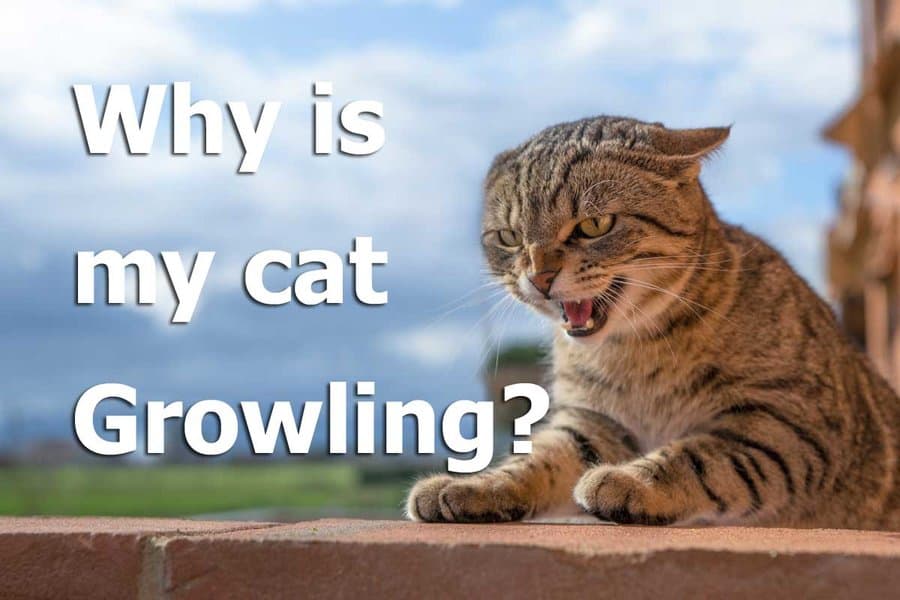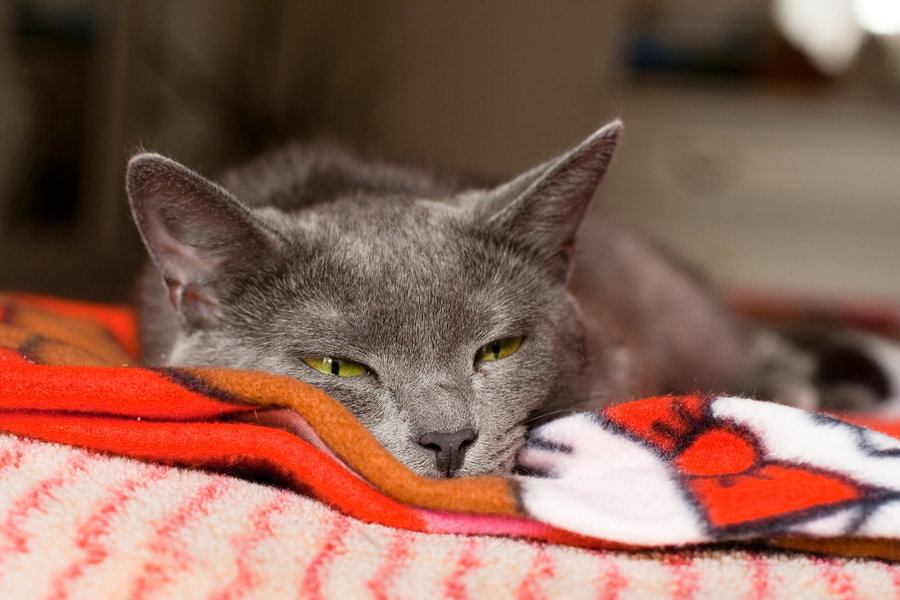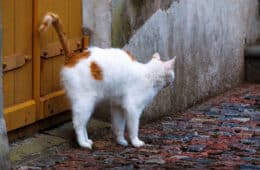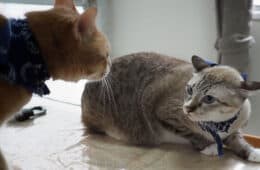Ever noticed that out-of-place, bone-chilling growl from your usually sweet-natured kitty? In one moment, it's all purrs, and in the next, it sounds like your fur buddy has turned into a little tiger. It's a startling switch, isn't it? Why is your cat growling? But what causes such a drastic change in your cat's behavior? Why does your fluffy friend suddenly turn into a ferocious feline?
In this article, we'll take a close look at your kitty's growling behavior. We'll explore what a cat's growl sounds like, and what causes your pet to go from purrs to growls. We'll guide you on what to do when this surprising behavior manifests, and how to maintain safety while your cat is growling.
Before we get started, a word of caution: every growl is a signal and not an invitation for a petting session. So, let's learn to respect the boundaries of our purring friends during their "bad moments".

What does cat growling sound like?
Growling is a low guttural sound that is a universal sign of aggression. When you hear a dog, a cat, or any other predator growl, you instinctively recognize it as a "do not approach" sound. Here's a classic growling sound (please use headphones and don't play the clips in this article on your speakers as it may upset your cats):
That was easy to identify as a growling sound, right?
Some cats don't have much of a "rumbling" effect in their growl. For these cats, look for something that sounds like a very low-pitched meow, coming from deep in their throat, something like this:
Not every low-pitched meow is a sign of aggression. Some cats will meow pitifully as a sign of fear or stress. Experienced cat owners can easily tell the difference by looking for other telltale signs of aggression.
Cats that are more likely to lash out will be immobile with the possible exception of a thrashing tail. The cat may arch its back (though not all cats do that). The pupils will likely be dilated and the ears may be flattened against the head. Growling is often accompanied by other hostile sounds, most commonly hissing.
Decoding Your Cat's Growl: What Does it Mean?
Growling is a cat's alarm bell, a clear cry for help. It indicates that your furry friend is feeling threatened, almost to the point of panic. This fear is so overwhelming that if you provoke your pet further, it might lash out in defense. Short and loud, a growl can become a prelude to an attack.
Understanding the Reasons Behind the Growl
Cats use growling as a defense mechanism, a vocalization that mirrors their fear and anxiety. The trigger for this fear is often a perceived threat, lurking somewhere in their environment. It could be a person they're unfamiliar with, another animal, or in many cases, another cat.
Your cat's growl is its way of communicating its dread. It's a stark message, a loud and clear statement: "I perceive this thing, this person, or this cat as a serious threat. It could harm me. I'm prepared to defend myself."
In such a situation, understanding and empathizing with your pet's fear is crucial. With this knowledge, you're better equipped to handle your growling cat and take the necessary steps to alleviate its stress. We'll get into the appropriate responses and actions in the following sections.
Remember, a growl is your cat's cry for help. It's crucial to respond with care, patience, and understanding. By doing so, you'll be able to maintain a safe and loving environment for your pet, even during their "bad moments".
SIGN UP FOR THECATSITE'S EMAIL UPDATES >
Managing the Growl: How to React When Your Cat is Growling
When your cat growls, it's time to act wisely. Take this warning to heart. It's serious.
Understanding Your Cat's State of Mind
Right now, your pet isn't in its usual friendly and relaxed state. Fear has taken over. Your pet is overwhelmed, and you might feel like a stranger to it.
Your cat's body is flooded with aggression hormones, priming it for the ancient "fight or flight" response. But in the confines of your home, flight often isn't an option. Your pet is more likely to choose to fight.
A growling cat is a stressed cat, and a stressed cat is a potential threat. If further provoked, your pet will defend itself. It'll fight tooth and claw against whatever it perceives as a threat, which could be anyone or anything.
Approaching your pet during this phase can lead to injuries. It's crucial to avoid any attempt to handle your pet when it's growling.
Never try to touch or get closer to a growling cat!
Do's and Don'ts When Your Cat is Growling
So, what's the best course of action when faced with a growling cat? Keep your distance. Avoid shouting or showing fear, as this could escalate the situation. Break eye contact and slowly retreat.
If you can identify and safely eliminate the cause of your cat's fear, do it. For example, if your pet spotted an unfamiliar animal on your porch, close the doors and windows to block the view.
Allowing Your Cat to Recover
Give your cat some space and time. Leave your pet alone for a few hours at least. This will help your cat regain its composure. Be patient, understanding that full recovery can take a while. Some cats might need a few days to get over a frightful incident.
Be vigilant for signs of stress or aggression in the following days. If your cat is hissing, growling, or showing signs of stress like dilated pupils, give your pet more time and space to calm down.
By understanding and acting appropriately during your pet's growling episodes, you ensure both your safety and your pet's wellbeing. Always remember, patience and understanding go a long way in maintaining a positive environment for your pet, even in their most challenging moments.
The Risk of Redirected Aggression: Dealing with a Growling Cat's Misplaced Fury
During growling episodes, your cat's fear can manifest in unpredictable ways. One such behavior is redirected aggression. It's essential to be aware of this risk and know how to respond.
What Redirected Aggression Looks Like
Sometimes, the source of your cat's fear might remain a mystery. Even if you do identify the cause, remember that your pet's fear response isn't necessarily logical. Your pet may perceive any nearby entity as a threat. This includes other pets, and yes, even you.
So, even if you're certain that your cat is upset with another cat or the family dog, don't assume it's safe to pet your kitty. Your cat's fear may blur the lines between friend and foe. Anyone who gets too close might be on the receiving end of its fear-fueled aggression.
Read more here: Re-directed Aggression In Cats
The Ripple Effect of Fear
This state of fear can also have a domino effect on other pets in your home. When one cat is growling and showing signs of aggression, other cats often pick up on the tension. They may become fearful and aggressive themselves.
In these situations, you might need to separate your pets until they all calm down. If you have a cat fight on your hands, follow the tips in this article: How To Safely Break Up A Cat Fight.
Respect and Empathy: The Key to a Harmonious Relationship
At the end of the day, our pets are part of our family. They're charming and playful, providing us with endless joy and companionship. Yet, they're not immune to stress and fear. It's our responsibility as pet owners to respect their boundaries and understand their "bad moments".
By learning to recognize signs of fear like growling, and responding appropriately, we can ensure a positive, loving relationship with our pets.
As we navigate these challenging times together, we create a safe and nurturing environment that helps our pets trust and bond with us for many years to come.
SIGN UP FOR THECATSITE'S EMAIL UPDATES >
Comments? Leave them in the comment section below. If you have specific questions and need help with understanding your cat's behavior, post your question in the cat behavior forums instead.
Note: We may get commissions for purchases made through links on this page.




2 comments on “Why Is My Cat Growling?”